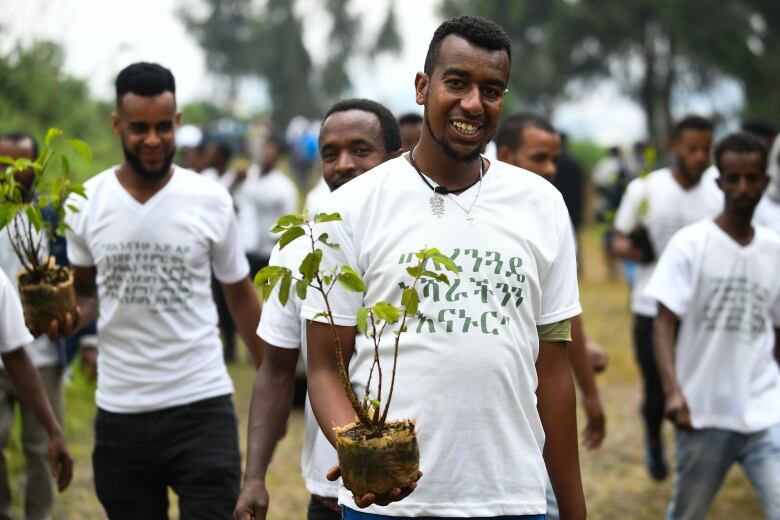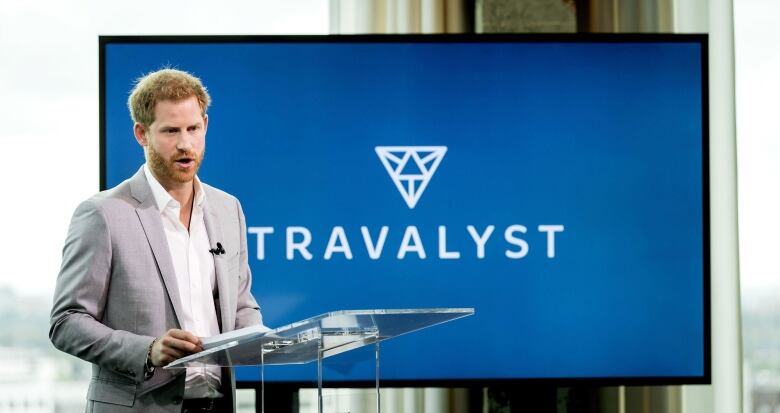How you can be part of the global tree-planting effort
Also: What can you do with captured carbon?

Hello, folks!This is our weekly newsletter on all things environmental, where we highlight trends and solutions that are moving us to a more sustainable world.(Sign up hereto get it in your inbox everyThursday.)
This week:
- How you can be part of the global tree-planting effort
- Prince Harry is trying to make tourism more sustainable
- What can you make with captured carbon? (A: Quite a bit)
How you can be part of the global tree-planting effort

A study published last month in the journal Science said the best way to fight climate change is to plant at least a trillion trees worldwide. Some countries have undertaken ambitious goals Ethiopia, for example, is aiming to plant four billion by October.
If you've been wanting to help in this worldwide effort, but aren't sure where to start, here are some pointers.
You have a yard. Now what?
You need to know what kind of soil you have it might contain a lot of clay, or sand or silt, for example. You also need to figure out what tree will grow best and how to care for it.
There are groups and organizations that will do that crucial legwork for you. Trees Winnipeg, for example, has a program that will match homeowners with the best tree for their yard, and even supply everything they'll need to get it off to a healthy start. There's also the non-profit organization LEAF (Local Enhancement and Appreciation of Forests), which works in and around Toronto.
Janet McKay, executive director of LEAF, said you can usually get a tree in just a few months, for about $200. That includes a 1.5- to two-metre deciduous tree and "a consultation with one of our arborists in the yard, which is the part that people really love," McKay said. They'll pick up the tree, bring it to your home and even do the digging.
What if you don't have a yard?
Just because you live on the 24th floor, with no outdoor space, doesn't mean you have to miss out. If your property manager or building owner is on board, you, too, can plant a tree.
LEAF can consult in this scenario, too. McKay said the key with multi-unit dwellings is knowing where underground parking and utility lines are. But it's not just about finding the best spot for the tree.
"We do ask [people] to have a tree care plan for us so that we know that the trees are going to be cared for," she said. LEAF recommends that for the first two to three years after planting, the trees are watered about twice a week, each time "with three watering cansized buckets full."
Can I make a donation so someone else can plant trees?
Absolutely. Tree Canada can help you do that. It's a registered charity that has been boosting the country's urban forests for more than 25 years.
For as little as $4, Canadians can pick a region from B.C. to Atlantic Canada to the North and even the approximate placement of a donated tree.
"We are one of the few sites that actually allow people to see where the trees get planted," said Cristiane Doherty, communications and marketing manager for Tree Canada. Once the site is chosen and the sapling has been planted, Tree Canada reports back to you. During the first five years, Tree Canada checks up on new trees to see how they're doing, and posts the survival rates on their website.
Still a trillion trees?
It all adds up. Tree Canada plants between 300,00 and 400,000 trees a year. LEAF, which has a more local mandate, plants 3,000 to 4,000.
"There is a lot of good that can be done, even with planting one tree or taking care of one tree," Doherty said. "When you plant, you're planning for tomorrow, and for the next generation."
Stephanie Hogan
Reader feedback
In response to recent stories about wildfires in the Amazon region, reader Sam Moore had this to say: "Canada is hardly in a position to feel 'holier than thou' when we are massacring B.C.'s rainforests for the sake of jobs and the economy. Will someone please explain how we are better than Brazil regarding deforestation?"
Comments or suggestions? Write us atwhatonearth@cbc.ca.
Old issues of What on Earth? are here.
The Big Picture: Prince Harry's quest for sustainable air travel
A few weeks ago, Prince Harry and his wife, Meghan Markle, came in for some environmental shaming after reports emerged that they used private jets to go to the French Riviera and the Spanish island of Ibiza. The prince took a commercial flight to Amsterdam earlier this week to launch Travalyst, a project aimed at making tourism more sustainable. (If it sounds opportunistic, the initiative has been in the works for a couple of years.) The Travalyst consortium includes companies such as TripAdvisor, Booking.com and Visa, and aims to educate consumers about the environmental footprint of travel, and how to reduce it. (Our colleague Janet Davison has more on this story in this week's issue of her newsletter, The Royal Fascinator sign up here to subscribe.)

Hot and bothered: Provocative ideas from around the web
-
One of the unfortunate aspects of the conversation about global climate action is that it has led a number of male columnists and politicians to make vicious, ad hominem attacks on public advocates such as Greta Thunberg and U.S. Congresswoman Alexandria Ocasio-Cortez. A Swedish study has found that there's a link between climate skepticism and misogyny.
- For a variety of reasons geography, climate and simple consumer preference Canadians drive a lot of big, heavy, gas-guzzling vehicles. As a result, we have the highest fuel consumption per kilometre driven of any country in the world.
- In another sign of the growing prominence of electric vehicles (EVs), England is set to become the first country to legislate that all new homes must have an EV charging port.
What can you make from captured carbon?

In nature, carbonis used to makedifferent materials, including minerals like limestone and graphite. Plants also suckup CO2 and use it to make things like fruits, vegetables and wood. Muchof that organic matter ultimately ends up underground in the soil, and caneventually becomeoil, coal and natural gas.
Unfortunately, humans have been taking a lot of that buried carbon and burning it, releasing huge amounts of CO2 into the atmosphere and causing rapid global warming. But what if we could turn CO2 into different useable items?
In theory, it would mean releasing less CO2 into the air. In fact, if CO2-based products were valuable enough, we might be motivated to suck it out of the atmosphere in order to make things. That's the concept behind carbon capture and utilization.
Right now, not a lot of CO2 is being captured, and very little of it is being re-used.
But many projects are underway to change that, including the NRG COSIA XPrize, which is offering $20 million US to companies that can convert CO2 into valuable products. Ten finalists are scaling up their carbon-conversion technologies in Calgary and Wyoming.
Here's a look at some of the things you can make with CO2.
Fuels
Right now, the biggest market for CO2 by far is for enhanced oil recovery, where CO2 is used to squeeze extra oil out of aging wells. That's helped support most carbon capture projects in Canada so far. The CO2 is permanently stored or "sequestered" underground afterward, reducing the net emissions of the oil produced this way.
It's also possible to make fuels directly from CO2. B.C.-based Carbon Engineering is using carbon to make liquid synthetic fuels such as gasoline, diesel and jet fuel, while Toronto-based XPrize finalist CERT is making fuels such as ethanol and methane.
Concrete and building materials
Halifax-based CarbonCure and U.S.-based Carbon UpCycling UCLA are two XPrize finalists working on concrete with a lower carbon footprint. (A third finalist, Montreal's Carbicrete, withdrew from the competition to focus on building a pilot plant in Quebec.)
Plastics
XPrize finalist C4X, which is jointly based in Suzhou, China, and Toronto, is making foam plastics for use in car and aircraft interiors and packaging. Meanwhile, Californian XPrize finalist Newlight is making biodegradable plastics that are used in bags, containers, phone cases and furniture.
Other consumer products
Calgary's CleanO2 and Ottawa-based Tandem Technical make potassium carbonate and calcium carbonate,respectively. Calcium carbonate (see photo above)can be turned into things like paint, toothpaste and fertilizer. CleanO2's product is already being turned into hand soap.
Chemicals and advanced materials
Many other chemicals and materials can also be made from CO2, including pharmaceuticals. You can even make some very exotic products such as carbon nanotubes, the focus of Virginia-based XPrize finalist C2CNT, and nanoparticles, which are being turned into corrosion-resistant coatings by Calgary-based finalist Carbon Upcycling Technologies.
You can learn more about carbon capture, storage and utilization here.
Emily Chung
Stay in touch!
Are there issues you'd like us to cover? Questions you want answered? Do you just want to share a kind word? We'd love to hear from you. Email us atwhatonearth@cbc.ca.
Sign up hereto getWhat on Earth?in yourinbox every Thursday.
Editor: Andre Mayer | Logo design: Skdt McNalty
Corrections
- An earlier version of this story said CO2 is found in minerals like limestone and graphite. In fact, carbon, not CO2, is found in those minerals, although the Earth's carbon cycle means carbon can originate as CO2.Sep 06, 2019 8:30 AM ET
- An earlier version of this story incorrectly said CleanO2 makes calcium carbonate from CO2. In fact, it makes potassium carbonate.Sep 06, 2019 10:01 AM ET












_(720p).jpg)


 OFFICIAL HD MUSIC VIDEO.jpg)
.jpg)



























































































